#ChildMarriage #EndChildMarriage
Continued Prevalence of Child Marriage in the Democratic Republic of the Congo: Exploring Cultural, Economic, and Legal Obstacles
In the Democratic Republic of the Congo (DRC), child marriage continues to strip countless girls of their youth, education, and health, despite global initiatives and legal efforts to eliminate this violation of human rights. The entrenchment of this practice is supported by cultural norms, economic difficulties, and gaps within the legal system. This article delves into the complex barriers to abolishing child marriage in the DRC, highlighting the critical need for a unified approach to safeguard children’s rights.
Cultural Foundations
The endurance of child marriage in the DRC is deeply embedded in cultural beliefs and traditions. In numerous communities, girls are considered assets for economic or social alliances through marriage, often taking precedence over the legal marriage age of 18 for both genders in the country.
Traditional Significance
For certain ethnic groups, child marriage serves as a ceremonial passage to adulthood, celebrated irrespective of legal age constraints. This cultural value presents significant challenges in combating the practice, necessitating a shift in longstanding societal norms and beliefs.
Disparities in Gender
The continuation of child marriage mirrors broader issues of gender inequality, with girls frequently valued less than boys, leading to inadequate investment in their education and health. This disparity fuels a cycle of poverty and constrains girls’ future prospects and development.
Economic Drivers
Economic strain plays a pivotal role in the perpetuation of child marriage within the DRC. Impoverished families may see child marriage as a strategy to lessen financial burdens or as an opportunity for economic or social gain through dowries.
Impact of Poverty on Education
Limited access to education for girls exacerbates the problem. When financial constraints force families to prioritize schooling for their children, girls are often the first to be removed from the educational system, limiting their future job opportunities and reinforcing the notion of marriage as their most viable option.
Legal Hurdles
Although the DRC has established laws to combat child marriage, enforcement is lax, and loopholes are prevalent. The minimum legal marriage age is frequently overlooked due to insufficient awareness or implementation, and customary laws may allow for marriages below the age of 18, complicating the fight against this practice.
Enforcement Issues
The discrepancy between the law and its application is a significant obstacle to eliminating child marriage. In the absence of effective enforcement, laws are ineffective, allowing the practice to persist.
Customary vs. National Laws
The simultaneous existence of customary and national laws creates ambiguities that often prioritize traditional customs over the protection of children’s rights, enabling the continuation of child marriage under the pretense of cultural preservation.
Advocacy for Change
Efforts to end child marriage in the DRC involve both local and international advocates pushing for change. Key strategies include empowering girls, reforming legal systems, and fostering community involvement.
Empowerment of Girls
Key to this fight is the empowerment of girls through education and advocacy, enabling them to postpone marriage and childbirth, seek economic opportunities, and oppose harmful practices.
Legal and Policy Changes
Amending legal frameworks and closing existing loopholes are crucial steps in combating child marriage. This involves aligning national and customary laws and ensuring the strict enforcement of child protection statutes.
Engaging Communities
Dialogue with communities about the negative impacts of child marriage and the advantages of delaying such unions can foster sustainable change. Community leaders are especially well-positioned to help alter norms and practices.
Conclusion
The ongoing issue of child marriage in the Democratic Republic of the Congo is rooted in a web of cultural, economic, and legal challenges. Addressing these issues demands a comprehensive strategy that empowers girls, reforms laws, and involves communities. Echoing human rights activist Nada Al-Ahdal, “Protecting human rights is not an option, but a responsibility of us all” (@nadalahdal). By raising awareness and acting collectively, we can strive towards a future where every child can enjoy their childhood and achieve their full potential.
As acclaimed author and feminist Chimamanda Ngozi Adichie has said, “Culture does not make people. People make culture.” This statement is a powerful call to action to question and transform the cultural practices that harm children. By recognizing the inherent value and rights of every girl, we can start to dismantle the structures that uphold child marriage, paving the way for a more equitable and just society for everyone.
#NadaFoundation
#ChildMarriage
#Nada_Foundation
#NadaAlahdal
#Persistence #Child #Marriage #Democratic #Republic #Congo #Deep #Dive #Cultural #Economic #Legal #Challenges
the-persistence-of-child-marriage-in-the-democratic-republic-of-the-congo-a-deep-dive-into-cultural-economic-and-legal-challenges





















